
The David sculptures hold a philosophical history of homosexuality, in art and practice. Through Neoplatonist thought, one can understand the depth of sexual identity in the David sculptures of Donatello, Verrocchio, and Michelangelo. However, it is Bernini’s David that can be considered a culmination of technical improvement of sculpting methods and the attention to human form, from the Renaissance all the way until the Baroque.
The Renaissance And How Affected The David Sculptures

During The Renaissance, there was newfound mental and sexual freedom due to a burgeoning of new philosophical thought. The notion of the male body being the height of beauty is not a new one, it is an idea that goes back to the times of the ancients. The Greeks had been the foundation for what could be considered the ideal male form, and after years of the body being concealed from the public, it was finally being rediscovered.
According to James Smalls in Homosexuality in Art, the Renaissance was a
“… rebirth. It refer[ed] specifically to a rebirth of Greek and Roman art, literature, philosophy, and science and, more broadly, a thirst for secular and empirical knowledge. The Renaissance [was] a kind of reversal of medieval goals in that artists of that period focused on the natural rather than the supernatural world. The individual and his experience was considered more important than the cultivation of a purely spiritual life. This change was due to the impact and influence of Humanism on the late fourteenth-century in Europe” (Smalls 73).

Not only that, amongst the change in philosophical thought and ideology there was the emergence of the Medici Family. The Medici House first began their patronage to art in 1419 for the reconstruction of the San Lorenzo. The Medici Family was known to drop top-dollar on art during the Renaissance. “Their extensive and enlightened patronage allowed art in all media to flourish” (Art Institute of Chicago), and further allowed artists of different crafts the means to create outside commissions for the church. They were now able to splurge on their creativity due to freedoms they were allowed by the many members of the Medici Family.
Get the latest articles delivered to your inbox
Sign up to our Free Weekly Newsletter
Due to the Medici’s love for diverse culture and thought, Lorenzo de’ Medici’s court consisted of many great Renaissance artists, such as Verrocchio, Michelangelo, and Leonardo da Vinci. Another known and important, member of his court was the Italian scholar Marsilio Ficino, and it can be assumed that these artists, and many more, heard and believed in his philosophical translations and teachings.
The Renaissance gave artists the chance to, once again, look upon the nude form without fear of the Church. The Church even embraced the rediscovery of the body, and then later, the nude form. Artists now were allowed more expression within their work knowing that they would not be seen as heretics.
Sexuality During The Renaissance: Ficino And Neoplatonism
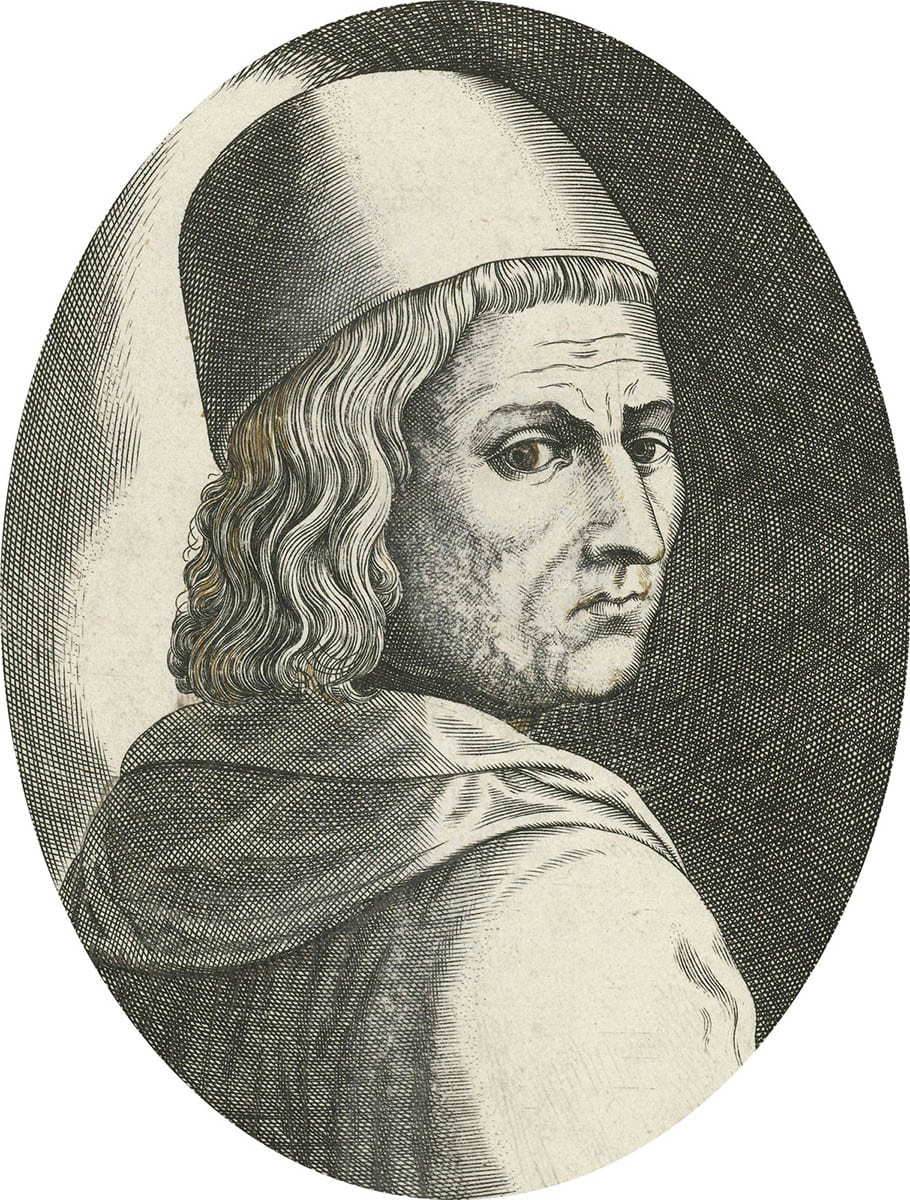
Many notable Renaissance artists were influenced by Neoplatonism, and more specifically with Ficino’s development of “a complex theory concerning the relationship between desire, sexuality, and religious contemplation.” Artists would now feel more tempted to combine sexuality, especially homosexuality, and art without trepidation. “Following Plato, Ficino stated that love is a desire for beauty… because sight…[is] our…most dominant physical sense…. For Ficino, a man is more ‘naturally’ drawn toward another… because the male reminds him of the ‘idea’ of his own inner beauty. Divine contemplation is spurred by another man’s beautiful forms. Ficino’s work helped legitimize homosexuality as a worthy topic of artistic and philosophical investigation, prompting other Renaissance philosophers to legitimize… a man’s desire for another man as a noble endeavor” (Smalls 77).
This way of thinking could be seen in The Sacred Band of Thebes, where it was said that the romantic and sexual connection that each soldier had with their partner is what made the band so strong.

Ficino’s interpretation of Plato’s theories was very important because it spurred on even more artistic freedoms within the Italian Renaissance. That is not to say that it was not without repercussions, there was still a chance of persecution due to open or blatant acts of homosexuality. However, it did not stop those who embraced his teachings from making some of the most influential works of the Renaissance.
An artist who was especially inspired by Ficino’s works was Donatello, who made daring contributions to the Renaissance.
Donatello’s First David (1408-09)

For Donatello’s first David, he conveyed a form that was both lithe and feminine — his sexuality is just peeking through with this piece. Many have believed that the pose of the sculpture was initially inspired by an Etruscan statuette of a goddess. If that wasn’t enough, the sculpture stands in a feminine, a very s-shaped, contrapposto with David’s leg peeking out from underneath his cloak coverings. His leg does not have the sinew and muscle of a man but the soft lines of femininity.
Typically, depictions of David were of him once he had already entered kinghood, not in his youth, but Donatello decided to sculpt him very youthfully and boyishly, with somehow giving David the sensibilities of a regal woman. His face is very androgynous, as well, juxtaposed against the hard masculinity of Goliath at David’s feet. Overall, the piece feels soft and feminine.
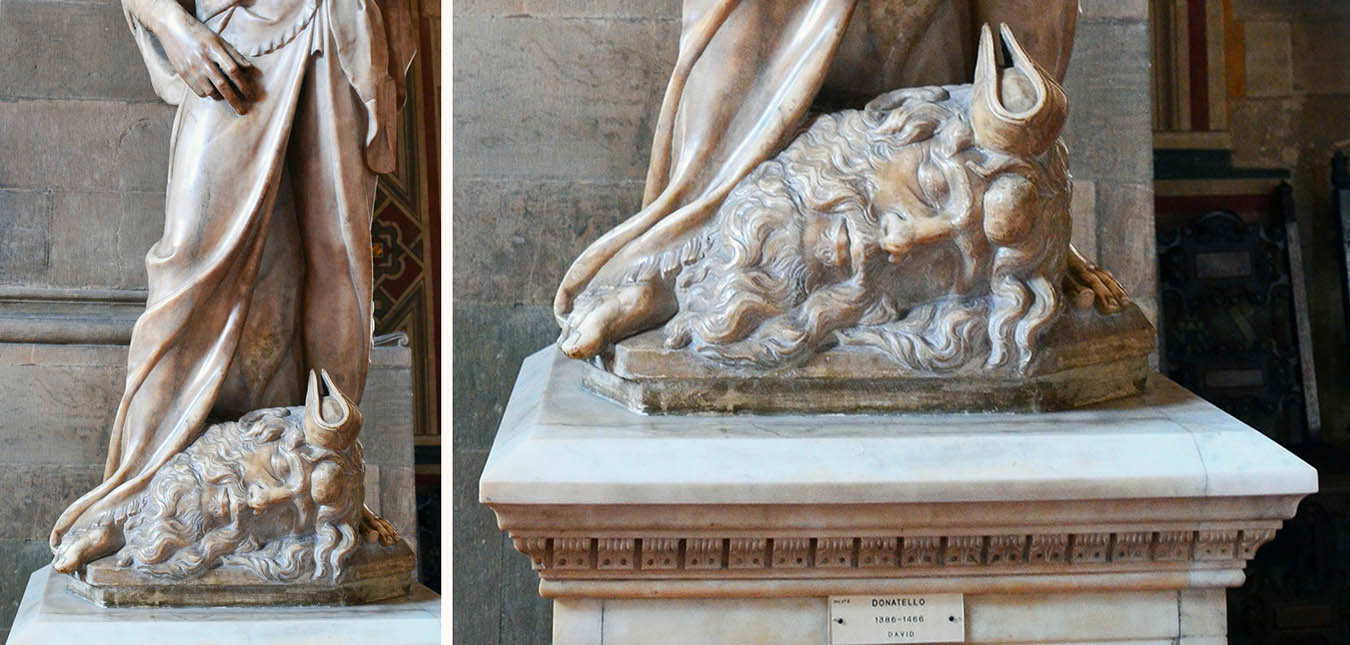
This rendition of Donatello’s David is not a homoerotic piece overall, especially when compared to its bronze counterpart, but it comes very close. It should be noted that “Donatello was perhaps one of the earliest artists of the Italian Renaissance influenced by Ficino’s ideas about male-to-male beauty and desire. Donatello is cited as one of the ‘first modern artists known to be homosexual, in a city (Florence) where homosexuality was infamous among artists, patrons, and audiences.’ (Saslow, p.82)” (Smalls 77).
Donatello was not afraid to include hints of his own sexuality in this piece. Its homosexual undertones can further be seen in David’s leg peeking through the fabrics, and its softness. From behind you will see the piece’s posterior does not hold the typical musculature and tightness of male sculptures, it is more soft and voluptuous. Such is especially evident in comparison to Michelangelo’s David, which is all tightness and muscle.
Despite the way this David holds himself, the piece maintains the look of a younger male whilst avoiding the hardlines that come with age. The hardest lines depicted are on the head of Goliath, a beast of a man. It caught my notice that the marble sculpture, his bronze, and Verrocchio’s David (1473-75) are the only pieces out of the five that use Goliath almost like a foil to further convey his youthfulness and have a comparison against his masculinity.
Donatello’s David Sculptures Versus Verrocchio’s

Verrocchio and Donatello’s marble and bronze David sculptures have the most effeminate looks to them out of the five. Their poses, body types and hidden meanings connote more obvious homosexual overtones. This is especially evident in Donatello’s bronze, as it is much more obvious than with Verrocchio’s David.
In the book, The Sculptures of Andrea Del Verrocchio, Andrew Butterfield stated that “as with the other David sculptures of the period… Verrocchio too preferred to represent David as a young lively boy rather than the idealized figure… Indeed, it should be remembered that when Verrocchio made his statue for the Medici, Donatello’s Bronze was almost certainly already at the center of the cortile of the Palazzo Medici…. The difference between the two were, therefore, presumably the result of a conscious decision by Verrocchio and Piero de’ Medici…” (Butterfield 28).
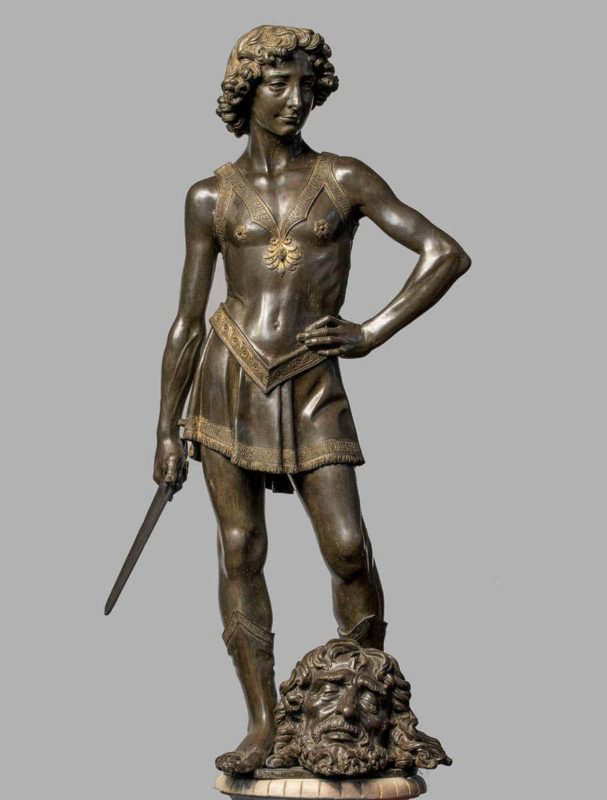
David by Andrea del Verrocchio,1473-75, via National Gallery of Art, Washington D.C.
These sculptures were “…a search for the androgyne and revealed a balanced combination of masculine strength and feminine tenderness” (Smalls 77). Comparing both of their bronzes, and Donatello’s marble, there is already plenty to be compared just based on how each piece was set up.
The bronzes stand in very similar postures, almost a mirror of one another, with a pushed-out knee for Donatello’s being the main difference. Andrew Butterfield said that there is also speculation that Verrocchio’s “figure originally had gilded hair, just as Donatello’s bronze” (Butterfield 18). They both have a very relaxed contrapposto, lacking the usual power that is supposed to exude from a typical contrapposto like Polykleitos’s original contrapposto as seen in his Diadoumenos and Doryphoros sculptures (which can be seen below).

The curve in the body of Verrocchio’s David, with the addition of the contrapposto, adds movement to the piece as well. Despite the feminine and somewhat sensual details, such as the golden flowers on his breastplate, purposefully painted over his nipples, there is still a lack of that same feminine yet still androgynous eroticism that Donatello’s bronze David sculpture has.
Furthermore, there is a definite gap between the two bronzes in terms of eroticism. Donatello’s holds more eroticism to it than Verrocchio’s, which has “the artist’s realistic treatment of David’s mood, anatomy, and dress” (Butterfield 20). Donatello’s bronze holds many inaccuracies in his feminization of the male form but there is also the fact that the legs are ridiculously elongated to add to its femininity. However, he still made the attempt to keep his rendition as “true to life” as possible.
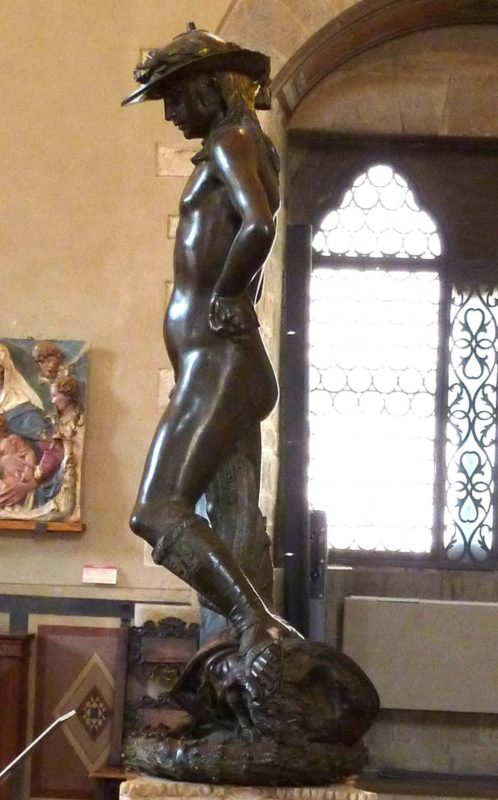
Donatello’s David holds “[his] deep-seated homoerotic desires as they had been fueled by the apprenticeship system. This structure of learning involved adolescent boys who were taken in as student assistants” (Smalls 77). So, it is not surprising that the piece lacks hypermasculinity, portraying softness and sensuality instead.
Not only that, Donatello’s David sculpture is far more supple than Verrocchio’s with attributes that are distinctly feminine. His body holds curves and softness in places that are not inherent to the male form. Michael Greenhalgh stated in his Donatello and His Sources that “[the sculpture] seen in profile, the angle of both stomach and rump is female… In addition, the rump is far too low slung for a male anatomy…. [There is a] female-like fatty tissue on the breasts and mons veneris…. The thighs are much too broad for a male and, indeed, the whole profile is that of a female” (Greenhalgh 166). Then again, it should be stated that this was more than just a homoerotic statement.

David’s form in Donatello’s bronze further references Neoplatonist thought through Plato’s Phaedrus, his dialogue on love. In Leonardo Bruni’s published translation, the characterization of the human soul is expressed as a single wing. The reaction of the wing is compared to a phallic erection when in contact with one’s beloved, stating: “The lower end of the wings begins to swell and grow to the root upwards,” which can be compared to the act of “the left-hand wing of Goliath’s helmet… steal[ing] surreptitiously up into [his] crotch” (Greenhalgh 167). It is very erotic, dripping with sexuality; the fact that Donatello’s overarching point can be understood from that single wing is astounding.
What can be concluded from the comparison of Verrocchio’s and Donatello’s bronzes is that despite how similar they seem, at first glance, they hold many physical differences, but maintain the same ideals and attention to sexuality. Verrocchio’s David sculpture is outfitted with armor and Donatello’s bronze is outfitted with the wares of a shepherd and laurel in his hair, but it all comes back to homosexuality and the sexual conversations that were resurfacing in the Renaissance.
Where Does Michelangelo’s David Come In?
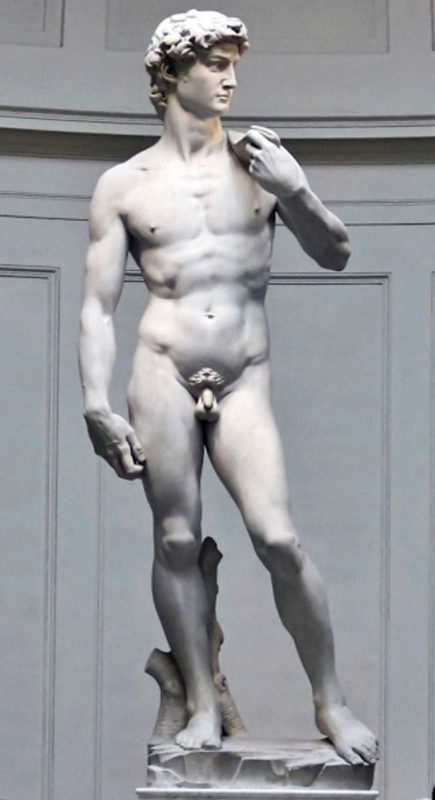
Earlier, I made references to Michelangelo’s David, but I have yet to give a thorough comparison. Between the David sculptures shown, so far, the one that would be most similar would be Donatello’s marble David, due to its elegance and simplicity.
First of all, Michelangelo’s David is in a league of its own compared to the others—and not just because it was Michelangelo who sculpted it. This David does have some Neoplatonist inspiration like the others, but that isn’t what makes it special either. Moreso it is the new style that was being used, “Michelangelo’s works from this period represent a new figurative style that the painter and writer Giorgio Vasari (1511–1574) called maniera (Mannerism), characterized by expressive power and complex, yet elegant, form” (The Art Institute of Chicago).
How Michelangelo sculpted David’s hand, for example, shows not only his skill but his attention to detail. In order to sculpt something like this, there has to be a great understanding of the human body and how it looks in action, which Michelangelo had. During the Renaissance, with the resurgence of Greek ideas came the use of the Golden Ratio, which simply creates balance with specific measurements in art and architecture. In Michelangelo’s David, it was the use of the triangle technique to create his well-balanced and proportioned David sculpture.

Donatello’s understanding was much more limited considering the human form was only coming back into the limelight with the early Renaissance, hence why his piece is more regal and lacks expression. Michelangelo contrasts his piece heavily, which is evident in the close up of David’s face. There is an intense look of concentration right before he is to go up against Goliath. His eyes are very expressive, and you can tell Michelangelo has studied how the face is supposed to move in certain “manners.” The Mannerism style is powerful because, with just a look, the viewer can understand the story that is being told. Bernini’s David is very expressive in this manner as well.
Bernini’s David Sculpture: A Culmination Of The Past

Bernini’s David is spectacular in that it is theater-in-still. It exemplifies the use of interactive drama that is seen in a lot of Baroque art. It also has the pyramid-like frame — unlike the triangle of the Renaissance — that can be seen in many Baroque sculptures to ensure the balance of the entire scene depicted. Unlike the previous David sculptures discussed, this one is the only one that was created outside of the Renaissance. Out of the four, Michelangelo’s is the only one that can be properly compared, due to Bernini’s use of Mannerism and grasp of the human form.
In the book, The World of Bernini, Wallace Robert comments on Bernini’s use of “psychological realism, an insistence on the credibility of the actions and emotions depicted…; [his] physical realism was equally important” (Wallace 18) to his pieces overall. He paid such close attention to the tension of David’s body in action that anyone viewing the piece would be able to see the muscles straining in his front leg and the curling of the toes of his front foot as he braces forward. “The three famous Davids of Donatello, Verrocchio, and Michelangelo are excellent examples of self-containment. Bernini’s David ‘is… far different’” (Wallace 19). This piece goes several steps further than Michelangelo because of Bernini’s thought process.

He did not see how a boyish and casual image of David slaying Goliath was realistic. Instead, he conveyed a David whose “body is that of a muscular young man and his determined and angry expression is the look of a back-country shepherd who really intends to kill his enemy” (Wallace 19). This is similar to Michelangelo’s in expression. There is no regality in this piece, just movement, and suspense, and strength. What is also impressive about Bernini’s rendition of David is that it is not just interactive, but it makes the viewer feel as if they are a mere spectator in the goings-on of the statue.
Bernini and Michelangelo’s David sculptures conveyed their appreciation of the body beyond just male to male attraction or male feminization like with Verrocchio or Donatello. They had an appreciation of the ideal form that the ancient Greeks and Romans had perfected in their eyes. Michelangelo and Bernini displayed the body in a way that had long since been lost.
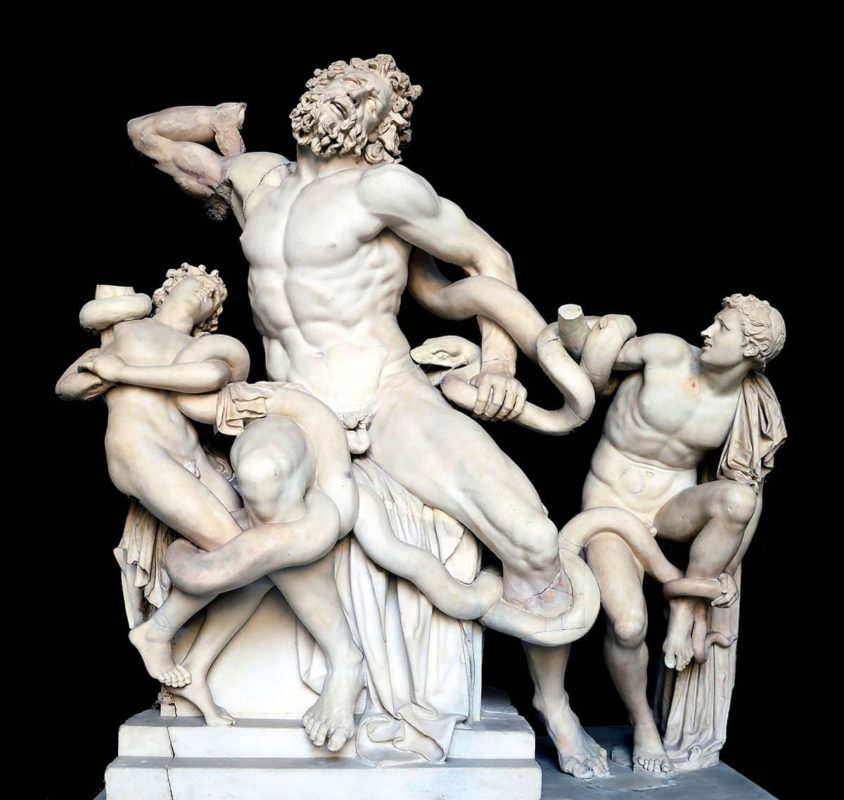
Laocoon and his Sons from 1st Century BCE, the Hellenistic period, had been rediscovered two years after Michelangelo’s completion of David, which ended up being the inspiration for his later pieces and the foundation for sculptures like Bernini’s. With all of the work and study done before him and passed down, it can be argued that Bernini mastered this age-old craft.








